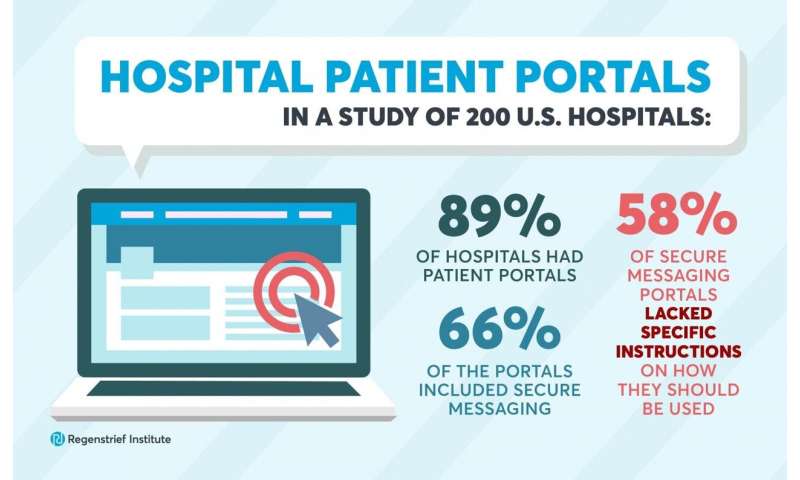
Most hospitals in the United States, but not all, have secure online websites called patient portals that give patients access to their personal health information. However, many hospitals fail to inform patients fully about using the portals, according to new research from Regenstrief Institute and Indiana University School of Medicine.
Patient portals offer the opportunity to expand people’s access to both their own health information and communication with their clinicians. A federal law, known as the Health Information Technology for Economic and Clinical Health (HITECH) Act, has provided financial incentives for healthcare providers to adopt these portals, and patients’ access to them has increased significantly over the last ten years. Clinicians, however, say they are concerned about patients misusing the portals, especially when it comes to electronic messages. Likewise, patients have expressed a desire for more guidance on using portals and secure messaging.
The goal of the new study, the most recent in Regenstrief Institute’s extensive work in the field of doctor-patient communications, was to determine the availability of hospital portals in the U.S. and what instructions were given to patients about using them. Researchers found:
- Portal instructions were more focused on operational and legal information, like how to sign on and liability limits, than on instructing the patient on what medical circumstances are best suited for portal use.
- More than half of portals with secure messaging did not have available guidance describing the appropriate uses of messages and practices relating to them. Many had generic statements describing secure messaging, such as “send and receive messages from staff,” but included no information on what message content would be considered appropriate.
- Some guidance used complicated language and vocabulary, which may hinder understanding by a general audience.
“We found that many instructional materials had more of a medicolegal focus, rather than a focus on the patient as a user,” said Joy L. Lee, Ph.D., M.S., Regenstrief research scientist and lead author of the paper. “This research indicates there is room for improvement when it comes to educating patients on the portals, especially related to secure messaging. The guidance that exists includes a lot of ‘don’ts’, but not very many ‘dos’. This makes it difficult for patients to properly utilize and benefit from the service.”
Content of patient portal guidance
Dr. Lee and the research team collected information from a random sample of 200 acute-care hospitals from across the U.S. The study team accessed publicly available portal information from hospital websites and called the hospitals to request any additional information that was distributed to patients about portals or messaging. Then they read and analyzed the content.
Some key results of the analysis were:
- Only 89 percent of hospitals had patient portals
- 66 percent of patient portals included secure messaging
- 58 percent of secure messaging portals did not detail how the patient was supposed to use the messaging.
Many hospitals included disclaimers that the messaging was not for emergencies, however 23 included that inside the “Terms and Conditions” section, which few patients may actually read.
“Hospitals and healthcare systems have invested a lot of money in patient portals, but the investment won’t pay off for them or the people they provide care for if patients are confused about how to use the portals or don’t understand how to get the most out of the tool,” said Dr. Lee.
“Hospitals and health systems are expanding their uses and provision of online resources, including patient portals,” said Michael Weiner, M.D., MPH, senior author of the article and associate director of Regenstrief Institute’s William M. Tierney Center for Health Services Research. “Health systems need to be active participants in engaging patients, providing them with more and better information, and clarifying expectations. As guidance is developed at a system level, clinicians can also guide conversations with their patients about how to use messaging tools.”
Source: Read Full Article
